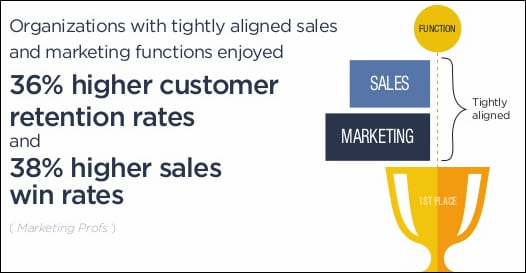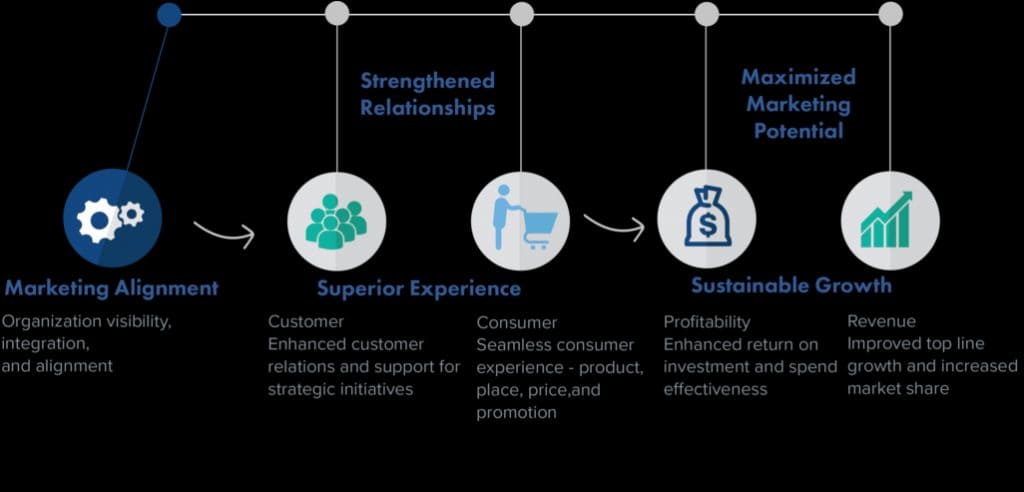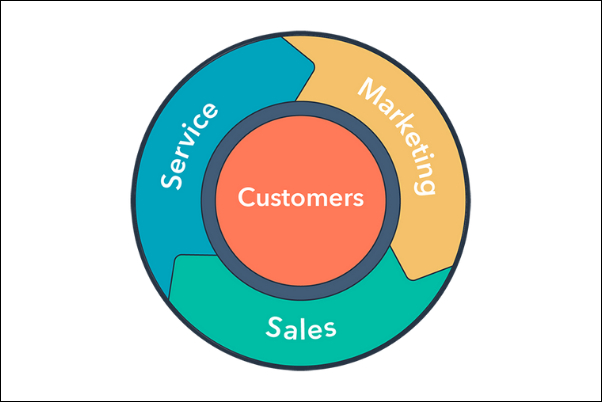How To Align Your Sales And Marketing Team
Table of Contents
We have outgrown the time when we could put the eggs of sales and marketing in different baskets. As we gradually left our ape-selves behind, the customer started to evolve. The customer of today wants a single-buyer experience. They need relevant marketing and effective sales. They’re not ready to be pestered with needless marketing and clingy salespeople. This is why we need to put our marketing and sales strategies on the same line. The alignment of sales and marketing is a crucial step in successful customer satisfaction and read more to find out why.
Organizations with a tight alignment of sales and marketing teams have a 36% higher customer retention rate and achieve 38% higher sales rates. The modern buyer does not depend upon you for information. The customer is socially driven and empowered, with access to unlimited information. And with modern-day strategies, marketing can help sales remain visible to the customer. Let’s tell why the alignment of sales and marketing, today, is a do-or-die situation.

Why Is This Alignment Crucial?
We know we have a flair for being a little dramatic, but do pay attention here. Sales and marketing misalignment can turn out to be fatal for your business. Because when both the wheels of your bicycle aren’t running in the same direction, you’re bound to fall off. So here are some of the reasons why you need to do what you need to do to keep your bicycle running!
1. Shift In Sales-Marketing Dynamics
In order to be successful, marketing teams must focus their strategies and actions on the buyers’ problems and opportunities. The product-oriented marketing strategy is gradually changing into a customer-oriented strategy. And this shift has resulted in the need for a shift in the sales-marketing dynamics. Disorientation between sales and marketing leads to irrelevant content, broken experiences, and low sales conversions. While a good alignment leads to better service, prompt responses, and overall harmony in the customer’s experience.
2. Irrelevant And Contradictory Customer Communication
43% of B2B marketing decision-makers report that their companies have lost sales as a consequence of not having necessary content at the right time for a specific customer and 77% of the rest have experienced costly delays. It is the lack of alignment between sales and marketing that makes the customer devoid of a good experience. When the sales and marketing teams are not in sync with each other, the customer keeps getting bombarded with irrelevant content.
Suppose a customer is confused about the kind of content type they should use for their experience. They have already had a talk with the sales team about it. And decided on a calculator. If the marketing team is unaware of this, they might send them outcome quizzes on the same. The customer might consider this as a miscommunication within the team. And consider your company to be incompetent in the area. Therefore, it is important for both teams to be aware of a lead’s position in the funnel. And of his place in his buyer’s journey. It is the only way to effectively being able to nurture your leads to provide them with a better experience.
3. Wastage Of Company Resources And Time
Of the main causes of discord between the sales and marketing teams is often lead generation. The marketing team blames sales for not following up on leads, while the sales team says that the leads are no good. But the real culprit behind this blame game is the misalignment between the two teams. The marketing team is not fully aware of what the sales team is looking for. And the sales team isn’t sure what the marketing team is providing the customer. As a result, this not only wastes money and time but also the potential of your personnel. This demotivates your team and reduces your conversion rates even further.
These are some immediate problems that arise with the lack of alignment of sales and marketing of a company. Now let’s talk about the sweet treats that come with this alignment. Naturally, the alignment of sales and the market offers plenty of benefits to all the areas of your business. Let’s see further!

4. Better Understanding Of The Customer
Even though marketing and sales are concerned with different parts of the process, they both interact with and engage leads and customers. And when the two are on the same page, it is much easier to create accurate buyer personas decide on target customers. Marketing and sales both need to understand what influences the buyer at what stage of their journey. The alignment of sales and marketing can improve the level and range of knowledge held by both sales and marketing teams, making them better equipped to obtain customers. The marketing team understands the kind of leads the sales team is looking for and provide more qualified leads.
The more qualified leads the marketing team provides, the shorter the buyer journey is. It not only saves money but the time and effort of the sales team. 70% of the respondents in the research said sales and marketing collaboration delivers a better buying experience for the customer. If a marketing team is aware of the sales cycle of a particular lead, they can curate content for them accordingly.
If the customer is at the top of the funnel, you can help them solve their problem. You can send them blog posts, e-books, and quizzes on what kind of product they would need to solve their problem. When the customer moves to the middle of the funnel, it means that you have captured their attention. Now you can educate the customer about the product through case studies and testimonials. You need to tell them how their product can be the solution to their problem. And once they have purchased your product, you can nurture your customers through feedback surveys and newsletters. Thus, try to retain them for further purchases.
5. Unified Brand Perception
“Your brand is what other people say about you when you’re not in the room.“
Jeff Bezos, CEO & Founder, Amazon
The customer needs a consistent idea of what your business is about. And truth be told, so do you. If your marketing and sales team are essentially selling different brands for your company, you cannot possibly achieve what’s best for your business. Where does your business fit in the market? How do you serve your customers? What problems do you solve? Who are you targeting? It is essential that your marketing and sales teams give you the same answer to these questions. When the marketing and sales teams act on these answers, the customer develops a uniform idea of your brand.
6. Leads Do Not Get Wasted
The alignment of sales and marketing ensures that marketing only sends forward the leads that actually have a chance of conversion. They target prospects and segment leads as per what the sales team is looking for and then send them further. These leads are more valuable and the sales team addresses them on time. This saves the time and resources previously wasted on dead-end leads, thereby increasing sales productivity and ultimately revenue. And what’s more, these potential prospects feel more attended to and taken care of. This develops not only a good brand image but also a sense of customer loyalty within them. And you do not lose any leads due to a lack of attention from the side of the sales team.
7. Agreement On Strategy
If you don’t agree on the destination, you’ll never be able to drive the same roads. Misalignment between sales and marketing more often than not results in disagreement on strategy. It is the marketing team’s job to make potential customers become aware of their product. And it is the sales team’s job to turn them into customers. The alignment of their strategies creates a better understanding of each other’s objectives. It allows them to work together better and consequently, bring in more sales. Marketing would know what the sales team expects from them. It can deliver the kind of leads the sales team want. These leads would be more qualified and easier to convert. And sales would understand the kind of approach they need to take toward the lead.

Strategies For Alignment Of Sales And Marketing
There are tonnes of strategies that you can employ for the alignment of your sales and marketing teams. But how do you choose what’s best for you? Well, that’s where we come into play! We’re here to tell you about the best possible ways through which you can achieve this alignment and do us proud!
1. Sales Enablement
The objective behind sales enablement is to integrate marketing and sales, along with other departments. It is done in order to improve an organization’s sales effectiveness. These departments work with sales and marketing to manage content and assets. They update guidelines and best practices, along with assisting them with sales onboarding and training, etc. You will have to create standardized guidelines and programs that include in-depth training, focusing on the value of engaging in social selling. The right sales enablement strategy equips sales representatives with the training, coaching, and content they need to be successful.
Companies looking to achieve a tighter alignment of sales and marketing are investing more in sales enablement. According to Aberdeen Group, companies that are best-in-class in their industry have 50% higher quota attainment than average companies, and those best-in-class companies are twice as likely to be investing in sales enablement.
2. Agree On A Buyer Persona
Not being able to define your ideal customer can lead to ineffective strategies. Marketing and sales, together, can only be successful when they have agreed on a buyer persona. A buyer persona is a semi-fictional representation of your ideal customer based on market research and real data about your existing customers. And the sales and marketing teams need to agree on the kind of lead they want to target for effective conversion.
This will help you identify what this ideal customer is looking for. Your campaigns will become more targeted and your sales approach will compliment it. Moreover, you will be able to recognize the challenges associated with the customer and tackle it more effectively. For example, suppose you are a high-end CRM software like Hubspot. Now, you know that startups that do not have a large marketing budget will not find you suitable for your needs. Therefore you will keep that in mind while creating your buyer persona and target firms with a greater marketing budget.
3. Track Joint KPIs
One of the biggest challenges that a company can face with the alignment of sales and marketing is different metrics. Most companies track separate metrics for their sales and marketing. This causes a hindrance in actually being able to figure out what’s working and what’s not. Sales teams are usually measured in numbers – new accounts, new conversions, or contract renewals.
Meanwhile, marketing teams are measured by engagement, quality, and brand awareness. If you decide on joint indicators, you will actually be able to figure out how effective your marketing is toward your sales. You will also be able to detect the weak areas in your customer acquisition funnel. Some of these indicators are sales cycle timeline, end-to-end ratio, and revenue per account.
4. Use Customer Feedback
The feedback that you get directly from your customers is one of the most valuable resources for the alignment of your sales and marketing. The feedback that is collected through sales reps can be used to identify pain points in their journey. Furthermore, you can improvise with your marketing techniques and the message that you deliver to your customers on the basis of this data. Sales representatives can also modify their approach towards the customers which aligns more with the marketing technique used.
The free flow of feedback from sales to marketing and vice versa is important to employ quick and prompt fixes. This improves the customer experience. It also makes them feel that their feedback is valued and consequently increases your customer retention.
5. Service Level Agreements
Companies are, by the day, trying to employ SLAs in their organization. SLAs between sales and marketing teams specify in writing what is expected out of both teams and clearly define the agreed-upon levels of performance. For example, for the marketing team, the deliverables could be a certain amount of prospect value. Each type of conversion that they gain could offer different values. The earlier the lead is in the buyer journey, the lower the value because the likelihood of its conversion is still low. The later the lead is in the buyer journey, the higher the value, for the same reasons.
For sales, the deliverables might include commitments on the follow-up of leads, reporting, documentation agreements, and reaching target metrics. When you combine these two sets of agreements, it is a clear understanding that both teams are working, what they are working on, and that their efforts clearly align with the combined team’s revenue targets.
So there were some great and foolproof strategies for the alignment of sales and marketing of your company. Now we have a question for you. Have you noticed how we keep talking about a ‘funnel’?
Now you may or may not know what the customer funnel is, but have something even better in store for you – the flywheel. And it’s as fun as a ride in an amusement park, unlike physics. Now, why are we talking about this flywheel all of a sudden? What does this have to do with the alignment of sales and marketing? Don’t worry, we’ll tell you all about it.
From The Funnel To The Flywheel
If you’ve been in marketing for a while, you must know the concept of the Marketing Funnel in and out. But if you don’t – It is simply a segmented journey of a lead’s conversion into a customer. They move from the awareness stage, into the consideration stage and finally into the decision stage. This is how the customer moves from the top of the funnel to the bottom. Although this funnel helps marketers look at a detailed, clear movement of a lead toward its conversion, there has been a debate about whether it adequately represents what really affects the customer in this entire journey.
Marketing Flywheel

The flywheel is similar to the funnel in that it represents the customer journey in three main stages – Attract, Engage, and Delight. But that’s where the similarities end. At the center of the wheel is the customer base. The rotation of the wheel is the growth of your business. Happy customers are the energy that fuels the growth of the flywheel.
As opposed to the funnel, the flywheel not only takes into consideration the buyer’s journey but also what influences them. It brings sales, marketing, and services together. And to bring them together for our little objective called customer experience. It takes into account what keeps the customer happy and what causes friction in the flywheel. A misalignment between the sales and marketing teams causes friction in the funnel, as well as stops, flow in the flywheel.
Funnels are exhaustive. They reach their end once the energy you put into them draws out from the bottom, But the flywheel restores and releases its energy! In a funnel model, you only focus on acquiring new customers. In the flywheel, you also focus on how you ‘delight’ them. And these happy customers act as fuel for the flywheel. And the model of the flywheel is possible only when there is an alignment of sales and marketing. It is because of the lack of alignment that more and more companies are retiring the funnel and moving toward the flywheel.
Key Takeaways
Key Takeaways Have you aligned your sales and marketing team yet? If not, don’t wait. We’re through with the whys and hows of this entire equation. Companies with tight alignments are doing better and better. It will not only keep your customers happy but your personnel too. Marketing and sales need to be cheese and cake – better together! And if you have any other questions, you know where to find us!
Antara Agarwal is a full time marketing consultant at Outgrow. She can be found packing her bags for her next trip, often to the mountains. And in one of those bags you will always find a half finished book she’s been struggling with for months.



